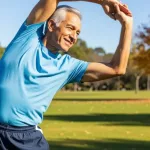
How mobility exercises are important for seniors?
Gaining mobility through targeted exercises can transform seniors' lives by enhancing independence and reducing injury risk, but how exactly does it work?


Does yoga build muscle? Many think of it as just stretching, but yoga can actually support strength and muscle development. Its poses demand sustained engagement, bodyweight resistance, and time under tension, ingredients that improve tone, stability, and endurance. But can it replace traditional strength training? For beginners and those aiming for functional strength, yoga can be surprisingly effective. While it may not match heavy lifting for sheer muscle size, adding yoga to your routine can boost mobility, reduce injury risk, and enhance overall performance.

Yoga enhances muscle strength by engaging various muscle groups through sustained poses and controlled movements.
This practice promotes muscle endurance and gradual strengthening without sudden strain. Emphasis on proper alignment and mindful breathing reduces injury risk, making it accessible and safe for many individuals.
Consistent practice supports balanced muscle development while encouraging body awareness and stability.
Building muscle through this practice involves targeting specific poses that effectively engage and challenge different muscle groups.
Poses such as Plank, Warrior II, Chair, and Downward Dog help build strength by requiring sustained muscle activation.
Practitioners should focus on proper alignment and gradual progression to minimize injury risk while maximizing muscle engagement and development safely.
Muscle development can be approached through various methods, each offering distinct benefits and challenges.
Traditional strength training typically focuses on lifting heavy weights to induce muscle growth, while yoga emphasizes bodyweight resistance and flexibility.
Although yoga can improve muscle tone and endurance safely, it generally produces less hypertrophy compared to conventional weight training, which is more effective for significant muscle mass increase.
You might also like to read: Benefits of Yoga
Different styles of yoga vary noticeably in their physical demands and potential to stimulate muscle growth.
More vigorous forms like Ashtanga and Power Yoga emphasize strength-building poses, promoting muscle engagement.
In contrast, gentler styles such as Hatha or Yin focus on flexibility and relaxation, offering limited muscle development.
Practitioners should choose styles aligning with their fitness level to minimize injury risk and guarantee safe practice.
Although yoga may not produce the same hypertrophic effects as traditional weightlifting, it effectively enhances muscle endurance and tone through sustained isometric holds and controlled movements.
These practices improve muscular stamina, allowing muscles to perform longer without fatigue. Additionally, yoga’s emphasis on alignment and gradual progression minimizes injury risk, making it a safe method to develop lean, resilient muscles over time.
Incorporating yoga into a muscle-building regimen can complement traditional strength training by enhancing flexibility, balance, and recovery.
Practicing yoga post-workout may reduce muscle stiffness and improve joint mobility, lowering injury risk.
Selecting gentle, restorative poses supports safe integration.
It is advisable to consult a fitness professional to tailor yoga sessions that align with individual strength goals and physical limitations.
While yoga is often associated primarily with flexibility and relaxation, several misconceptions persist regarding its capacity to promote muscle growth.
Some believe yoga lacks intensity to build strength, but many poses engage multiple muscle groups effectively.
Others think only weightlifting builds muscle, overlooking yoga’s potential for safe, gradual muscle development when practiced consistently and correctly.
Yoga contributes to muscle strength and endurance, primarily through bodyweight resistance and sustained isometric holds. While it may not lead to the pronounced muscle growth seen with traditional weightlifting, yoga effectively enhances muscle tone, balance, and stability. Different styles, such as Ashtanga and Power Yoga, emphasize strength-building, making yoga a valuable complement to conventional training. Overall, yoga supports well-rounded muscle development and body awareness, reinforcing its role in a thorough fitness regimen.

Gaining mobility through targeted exercises can transform seniors' lives by enhancing independence and reducing injury risk, but how exactly does it work?

Jumpstart your strength training by syncing workouts with your menstrual cycle—discover the surprising benefits that await when you train with your body’s rhythm.

Get the best techniques to stretch your knee effectively and safely, improving flexibility and preventing injury—discover the key moves you shouldn’t miss.

Learn how stretching before exercise boosts performance and prevents injuries, unlocking benefits you might be missing out on. Discover the key reasons now.

The ultimate guide reveals essential techniques and tips to prevent injuries—discover how simple changes can protect your body and enhance your performance today.

Wondering if stretching after working out is truly mandatory? Discover the surprising benefits and expert insights that might change your routine forever.